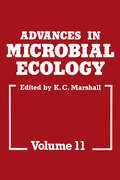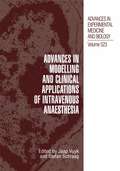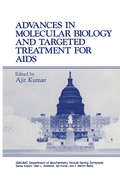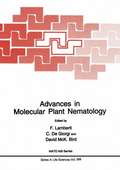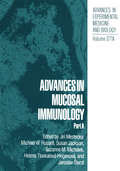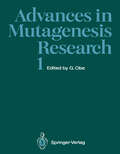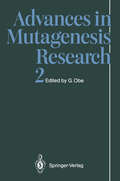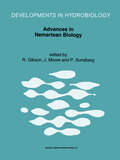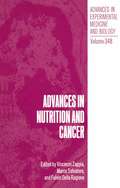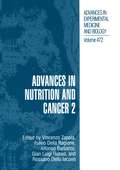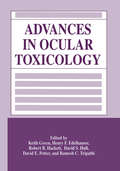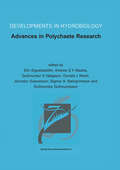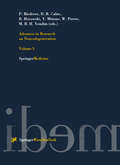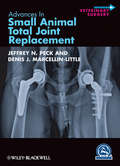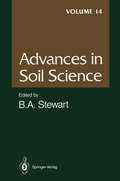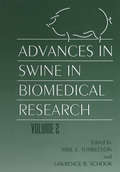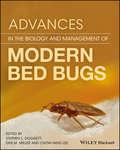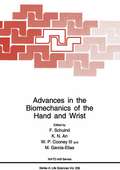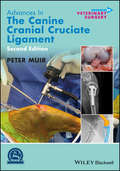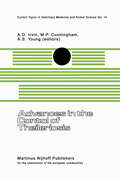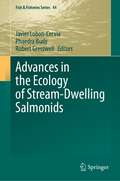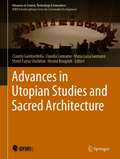- Table View
- List View
Advances in Microbial Ecology (Advances in Microbial Ecology #11)
by K. C. MarshallThe International Committee on Microbial Ecology (ICOME) sponsors both the Interna tional Symposium on Microbial Ecology, held in various parts of the world at three-year intervals, and the publication of Advances in Microbial Ecology. Advances was estab lished to provide a vehicle for in-depth, critical, and even provocative reviews in microbial ecology and is now recognized as a major source of information for both practicing and prospective microbial ecologists. The Editorial Board of Advances nor mally solicits contributions from established workers in particular areas of microbial ecology, but individuals are encouraged to submit outlines of unsolicited contributions to any member of the Editorial Board for consideration for pUblication in Advances. Chapters in Volume 11 of Advances in Microbial Ecology include those on micro bial transformations of chitin by G. W. Gooday, organic sulfur compounds by D. P. Kelly and N. A. Smith, and phosphorus, including its removal in waste water treatment plants, by D. F. Toerien, A. Gerber, L. H. Lotter, and T. E. Cloete. The importance of diffusion processes in microbial ecology is discussed by A. L. Koch, and 1. I. Prosser reviews the application of mathematical modeling to nitrification processes. Considera tions of particular ecosystems include the Antarctic by D. D. Wynn-Williams and Australian coastal microbial mats by G. W. Skyring and 1. Bauld. Other chapters include the regulation of N2 fixation by H. W.
Advances in Modelling and Clinical Application of Intravenous Anaesthesia (Advances in Experimental Medicine and Biology #523)
by Jaap Vuyk Stefan SchraagSince its launch in 1998 the European Society for Intravenous Anaesthesia (EuroSIVA) has come a long way in providing educational material and supporting the research and clinical application of intravenous anaesthesia. After the first two annual meetings held in Barcelona and Amsterdam in 1998 and 1999, three other successful meetings took place in Vienna, Gothenburg and Nice in 2000, 2001 and 2002. Next to these main meetings, starting in the year 2000, a smaller winter meeting has been organised every last week of January in Crans Montana, Switzerland. Both the main summer and the winter meetings breathe the same atmosphere of sharing the latest on intravenous anaesthesia research in the presence of a friendly environment and good company. Since the first meetings the educational tools of EuroSIVA have increased in quantity and technical quality allowing digital slide and video presentation along with the use of the computer simulation program TIVAtrainer during the speaker sessions and the workshops. Furthermore, EuroSIVA now exploits a website www. eurosiva. org that allows for continuous exchange of information on intravenous anaesthesia, the TIVAtrainer, the EuroSIVA meetings and online registration for these meetings. The EuroSIVA is currently engaged in friendly contacts with the Asian Oceanic Society for Intravenous Anaesthesia (AOSIVA), the United Kingdom Society for Intravenous Anaesthesia (UKSIVA), the Korean Society for Intravenous Anaesthesia (KSIVA), the European Society of Anaesthesiology (ESA) and the International Society for Applied Pharmacology (ISAP).
Advances in Molecular Biology and Targeted Treatment for AIDS (Gwumc Department of Biochemistry and Molecular Biology Annual Spring Symposia)
by Ajit KumarSince the discovery of HIV-l as the etiologic agent of acquired immunodeficiency syndrome (AIDS) in the early 1980s, remarkable progress has been made in both the basic understanding of the biological processes leading to AIDS and an accelerated effort in finding new treatments. As is often the case in rapidly advancing fields, most of the scientific discussions are best handled in specialized groups. The effort to organize a meeting on advances in molecular biology and targeted treatment for AIDS was an experiment of sorts to gather experts in selected areas of overlapping interests where advances in basic biology and its application in the development of new drugs could be discussed. Of necessity, the scope of the meeting had to be limited to maintain a certain focus. Important areas of rapid development in AIDS research, such as the vaccine development, epidemiology, animal models, etc. , had to be left out for more specialized meetings. The result, from all accounts, appeared to be quite a successful gathering, which provided a forum for informal discussions among scientists from industry and academic institutions. A remarkable feature of the AIDS virus is its genetic complexity and how some of its seemingly "extra genes" manage to regulate the normal functions of the host and most importantly its immune system.
Advances in Molecular Plant Nematology (Nato Science Series A: #268)
by F. Lamberti C. De Giorgi David McK. BirdPlant parasitic nematodes are a main pest to crops. For ex am pie, the root-knot nematodes belonging to the genus Meloidogyne are worldwide in their distribution and attack almost every type of crop, causing considerable losses of yield and affecting quality of produce. The cyst nematodes within the genera Globodera and Heterodera constitute a major group of plant pathogens in many countries throughout the world, suppressing yields of potato, sugar beet, soybean and cereals. Several nematodes such as longidorids and trichodorids are implicated in the transmission of numerous plant viruses. Many others cause constraints to agricultural production either locally or on large areas. However, despite their economic importance (they account for worldwide crop reduction in excess of 10%), plant parasitic nematodes are still poorly understood, because most of them are obligate parasites of roots. Environmental concerns over the agricultural use of pesticides demand the development of alternative measures to control them. To achieve environmentally sound control, knowledge of the basic biology of nematodes must be expanded. Important research areas include understanding the molecular bases for pathogenicity, the molecular mechanisms of the host parasite interactions and the genetic bases for population fluctuations. The workshop has, for the first time, brought together an international group of researchers using molecular approaches to study plant parasitic nematodes and their host responses.
Advances in Mucosal Immunology: Part A (Advances in Experimental Medicine and Biology #371)
by Jiri Mestecky Michael W. Russell Susan Jackson Suzanne M. Michalek Helena TlaskalováHogenová Jaroslav SterzlThe Seventh International Congress of Mucosal Immunology held in Prague, the beautiful old capital of The Czech Republic, 16-20 August 1992, was the first to be sponsored by the Society for Mucosal Immunology, and was the largest since their inception 20 years earlier in Birmingham, Alabama. It was attended by 624 participants who gave 538 presentations, more than 10 times the numbers of the first meeting; these proceedings contain 354 papers that were submitted for publication. The political events in Europe that made it possible to hold this Congress in Prague also allowed for the first time the participation of large numbers of scientists from Eastern Europe, as weil as from Asia, and the organizers were truly gratified by this happy circumstance. It is now clear not only that mucosal immunityencompasses the huge area of mucosal surfaces and most physiological organ systems, but also that mucosal immunology extends over the whole global surface and all continents! The sheer size of the Congress and number of manuscripts unfortunately entailed some unexpected problems in editing and assembling the proceedings, partly due to the diversity of linguistic styles not represented at earlier meetings, and we apologize to the authors who have patiently awaited the publication of their contributions.
Advances in Mutagenesis Research (Advances in Mutagenesis Research #1)
by M. Bauchinger F. K. Ennever H. Hayatsu R. Huber C. Kessler I. Mellon H. Nöthel C. A. Smith R. M. SpeedThe new field of applied genetic research, genetic toxicology and mutation research investigates the mutagenicity and cancerogenicity of chemicals and other agents. Permanent changes in genes and chromosomes, or genome mutations, can be induced by a plethora of agents, including ionizing and nonionizing radiations, chemicals, and viruses. Mutagenesis research has two aims: (1) to understand the molecular mechanisms leading to mutations, and (2) to prevent a thoughtless introduction of mutagenic agents into our environment. Both aspects, namely, basic and applied, will be treated in the new series Advances in Mutagenesis Research.
Advances in Mutagenesis Research 2 (Advances in Mutagenesis Research #2)
by E. E. Castilla R. Drouin J. Filipski E. Gebhart G. P. Holmquist P. Kasper J.S. Lopez-Camelo S. Madle K. Müller L. Müller J. Piper J. Pohl-Rüling C. L. Richer T.M. Schroeder-Kurth R. SodThe new field of applied genetic research, genetic toxicology and mutation research investigates the muta- genicity and cancerogenicity of chemicals and other agents. Permanent changes in genes and chromosomes, or genome mutations, can be induced by a plethora of agents, including ionizing and nonionizing radiations, chemicals, and viruses. Mutagenesis research has two aims: (1) to understand the molecular mechanisms leading to mutations, and (2) to prevent a thoughtless introduction of mutagenic agents into our environment. Both aspects, namely, basic and applied, will be treated in the new series Advances in Mutagenesis Research.
Advances in Nemertean Biology: Proceedings of the Third International Meeting on Nemertean Biology, Y Coleg Normal, Bangor, North Wales, August 10–15, 1991 (Developments in Hydrobiology #89)
by R. Gibson J. Moore Per LundbergIn any scientific discipline, meetings with presented papers and discussions are the most effective stimulus to the advancement of knowledge. Nemerteans have long been largely neglected because their taxonomy is difficult: the need for histological study of serial sections has proved inhibiting to most zoologists. During the last twenty years, however, this intriguing phylum has attracted the attention both of increasing numbers of taxonomists as well as of workers interested in many aspects of, for example, their ecology, evolution, physiology and fine structure. The enthusiam stemming from the First International Meeting held in Philadelphia during December 1983 made it abudantly clear that regular meetings of this type should be continued. The Second, at the Tjärnö Marine Biological Laboratory in Sweden (August 1986), emphasized the importance of such international gatherings. The Third Meeting was held in Britain, at Y Coleg Normal, Bangor, North Wales, August 10--15, 1991, with 24 participants from six countries. This volume records most of the papers given at the conference.
Advances in Nutrition and Cancer (Advances in Experimental Medicine and Biology #348)
by Vincenzo Zappia Marco Salvatore Fulvio Della RagioneThis volume contains the scientific contributions presented at the International Symposium held in Naples, Italy, in November 1992 at the National Tumor Institute "Fondazione Pascale". The Meeting gathered together experts from different disciplines, all involved in the vital and timely subject of Nutrition and Cancer. About 15 years ago a consensus among cancer epidemiologists began to emerge suggesting that diet might be responsible for 30-60% of the cancers in the developed world. The best estimate, reported in a now classical paper by Richard Doll and Richard Peto (1981), was that by dietary modification, it would be possible to reduce fatal cancers by about 35%. Within about six years there was widespread agreement that the principal changes required were a reduction in consumption of fat, along with an increase in the consumption of fruit, green and yellow vegetables, dietary fiber, and some micronutrients. Attention was also paid to the methods of cooking and preservation of foodstuffs. On the other hand very few, if any, effects were attributed to food additives and to pollution of food by trace pesticides, to which the general public often gives unfounded importance.
Advances in Nutrition and Cancer 2 (Advances in Experimental Medicine and Biology #472)
by Vincenzo ZappiaThis volume includes contributions presented at the Second International Sym posium on Nutrition and Cancer, held in Naples, Italy, in October 1998 at the National Tumor Institute "Fondazione Pascale." During the Conference, experts from different disciplines discussed pivotal and timely subjects on the interactions between human nutrition and the development of malignancies. Comparing the themes of this Meeting with those discussed at the First Sympo sium in 1992, the major scientific advancements certainly derive from the extensive use of molecular approaches to perform research in nutrition. Moreover, the fundamental observation of R. Doll and R. Peto (1981), which suggested that at least 35% of all cancers (with large differences among different tumors) might be prevented by dietary regimens, has been definitively confirmed by epidemiological studies. On the other hand, the relationships between diet and cancer are quite intricate and complex; it is difficult, and at the same time not methodologically correct, to reduce them to simple terms. Metabolic and hormonal factors, contaminants and biological agents, and deficiency of specific protective nutrients are all pieces of the same puzzle.
Advances in Ocular Toxicology
by Ramesh C. Tripathi David E. Potter David S. Hull Robert B. Hackett Henry F. Edelhauser KeithGreenThis volume represents the proceedings of the Fifth Congress of the International Society of Ocular Toxicology (ISOT), which was held at the Grove Park Inn and Resort in Asheville, North Carolina, October 13-17, 1996. We are delighted to present this volume to the ophthalmic community, especially those with a significant interest in ocular toxicol ogy. The Fifth Congress was developed around themes relating to ocular drug metabolism, the ocular pathophysiological effects of nitric oxide, government issues relating to the use of alternative methods for toxicity testing, and a workshop that encompassed comparisons of both in vitro versus in vivo models as well as different animal models. The outcome of this congress, embodied in this volume, is a contribution to the methodologies currently employed or under development and to various drug or physical effects on different ocular tissues. While the focus of this proceedings is on ocular effects of drugs or other materials, many of the contributions deal with topics that have a much broader interest. The workshop concerning the use of different model systems and the choice of the best animal model for drug testing covers a wide range of interests that ex tends far beyond specific ocular effects. This is especially true in the area of alternative methods and in the choice of the best animal model for examination of different disease entities.
Advances in Polychaete Research (Developments in Hydrobiology #170)
by Elin Sigvaldadottir Andrew S. Y. Mackie Gudmundur V. Helgason Donald J. Reish Jorundur Svavarsson Sigmar A. Steingrimsson Gudmundur GudmundssonIn July 2001 experts from all around the world met in Reykjavik, Iceland to discuss various issues of polychaete biology. In particular the latest developments in cladistic inference of polychaete phylogeny were presented. Some studies applied recent molecular techniques, revealing unknown genetic relationships between the different families of polychaetous annelids. This volume is of interest to specialists and students seeking an introduction to the latest developments in the field of systematics and ecology of polychaetous annelids. This book is one in a series presenting results from the International Polychaete conferences.
Advances in Research on Neurodegeneration: Volume 5 (Journal of Neural Transmission. Supplementa #50)
by P. Riederer, D. B. Calne, R. Horowski, Y. Mizuno, W. Poewe and M. B. H. YoudimVolume 5 of the series "Advances in Research on Neurodegeneration" is concerned with themes which are currently the focus of intensive research, and in which advances in our understanding of the pathological mechanisms un derlying neurodegenerative diseases are expected in the near future. The first section contains five reviews devoted to the various neuroimaging technolo gies. The discussion is concerned with the question of whether neuroimaging techniques make it possible to follow the process of degeneration as it occurs, and which methods offer the required sensitivity and quantifiability for this purpose. However, the question needs to be examined of whether, given the physical and chemical limitations of these techniques, even under optimal conditions, anatomical resolution can be improved to the extent that neuro degenerative diseases can be diagnosed earlier than currently possible and a confident diagnosis made. The possibilities of using neuroimaging techniques to provide information regarding the effects of neuroprotective or neuroregen erative therapeutic strategies, and for correlating the results of neuropsycho logical research with imaging data are also discussed. The second section is concerned with the significance of endogenous or exogenous neurotoxins as triggers for neurodegenerative processes that may lead to Parkinsonism. Vulnerability factors, which include such factors as nerve ending sensitivity, the synergistic effects of drugs and the various mechanisms underlying different toxins are discussed.
Advances in Small Animal Total Joint Replacement (AVS Advances in Veterinary Surgery #6)
by Jeffrey N. Peck Denis J. Marcellin-LittleAdvances in Small Animal Total Joint Replacement provides an up-to-date, comprehensive examination of joint replacement in veterinary surgery. Part of the Advances in Veterinary Surgery series copublished with the ACVS Foundation, the book presents an evidence-based, multi-system examination of the current state of hip, knee, and elbow replacement in dogs and cats, including information on biomechanics and biomaterials not found in other sources. Written by an international group of experts, the book offers guidance on the history, indications, contraindications, clinical procedures, and a review of the current literature for these surgical techniques. Focusing on replacement of the hip, knee, and elbow, the book also covers disc, shoulder, carpus, and tarsus replacement, as well as information on the development of custom prostheses. Each section incorporates information on potential complications and outcomes assessment. Advances in Small Animal Total Joint Replacement is an unparalleled repository of information for veterinary surgeons, residents, and practitioners with an interest in these procedures.
Advances in Small Animal Total Joint Replacement (AVS Advances in Veterinary Surgery #5)
by Jeffrey N. Peck Denis J. Marcellin-LittleAdvances in Small Animal Total Joint Replacement provides an up-to-date, comprehensive examination of joint replacement in veterinary surgery. Part of the Advances in Veterinary Surgery series copublished with the ACVS Foundation, the book presents an evidence-based, multi-system examination of the current state of hip, knee, and elbow replacement in dogs and cats, including information on biomechanics and biomaterials not found in other sources. Written by an international group of experts, the book offers guidance on the history, indications, contraindications, clinical procedures, and a review of the current literature for these surgical techniques. Focusing on replacement of the hip, knee, and elbow, the book also covers disc, shoulder, carpus, and tarsus replacement, as well as information on the development of custom prostheses. Each section incorporates information on potential complications and outcomes assessment. Advances in Small Animal Total Joint Replacement is an unparalleled repository of information for veterinary surgeons, residents, and practitioners with an interest in these procedures.
Advances in Soil Science: Volume 14 (Advances in Soil Science #14)
by J. B. Harsh J. M. McCray L. K. Porter J. S. Schepers N. Senesi S. J. Smith M. E. Sumner S. J. Traina S. XuThe study of soils today has taken on increased importance because a rapidly expanding population is placing demands on the soil never before experienced. This has led to an increase in land degradation. Land degradation is one of the most severe problems facing mankind. Volume 11 of Advances in Soil Science was devoted entirely to this critical area of soil science. From the beginning of agriculture until about 1950, increased food production came almost entirely from expanding the cropland base. Since 1950, however, the yield per unit of land area for major crops has increased dramatically. Much of the increase in yields was because of increased inputs of energy. Between 1950 and 1985, the farm tractor fleet quadrupled, world irrigated area tripled, and use of fertilizer increased ninefold. Between 1950 and 1985, the total energy used in world agriculture increased 6. 9 times. Until recently, sustainability was seldom, if ever, mentioned in agricultural literature. Now, it is one of the most widely used terms. The high costs ofirriga tion development, escalating energy costs during the 1970s, public concern over potential negative impacts of fertilizer and pesticides on water supplies, soil ero sion, soil compaction and salinity problems, and other concerns have caused many people to question whether many of the present agriculture systems can be sustained. As a result, soil science is beginning to focus more on sustaining the resource base.
Advances in Swine in Biomedical Research: Volume 2
by Lawrence B. Schook and Mike E. TumblesonSimilarities in structure and function between pigs and human beings include size, feeding patterns, digestive physiology, dietary habits, kidney structure and function, pulmo nary vascular bed structure, coronary artery distribution, propensity to obesity, respiratory rates, tidal volumes and social behaviors. Since the pig is an omnivore, it provides an adaptable model to evaluate chronic and acute exposures to xenobiotics such as alcohoL caffeine, tobacco, food additives and environmental pollutants. Swine have been used successfully as models to evaluate alcoholism, diabetes, absorption, digestion, total paren teral nutrition, organ transplantation, atherosclerosis, exercise, hypertension. hemorrhagic hypotension, melanoma, gingivitis, obstructive and reflux nephropathy. osteochondrosis. dermal healing and septic shock. A severe and worsening shortage of organs and tissues for transplantation in patients with severe organ failure has encouraged the consideration of inter species or xenotransplan tation. In developing programs toward this end, the pig generally is viewed as the preferred donor because of its size, physiology and availability. The pig harbors relatively few diseases which could be transmitted inadvertently to human patients. The ability to genetically modify swine to ameliorate the consequences of the human immune response offers a further significant advantage. Another important consideration for an animal model is that basic biologic back ground information be available for investigators to design future prospective studies.
Advances in the Biology and Management of Modern Bed Bugs
by Stephen L. Doggett Dini M. Miller Chow‐Yang LeeThe first comprehensive scholarly treatment of bed bugs since 1966 This book updates and expands on existing material on bed bugs with an emphasis on the worldwide resurgence of both the common bed bug, Cimex lectularius L., and the tropical bed bug, Cimex hemipterus (F.). It incorporates extensive new data from a wide range of basic and applied research, as well as the recently observed medical, legal, and regulatory impacts of bed bugs. Advances in the Biology and Management of Modern Bed Bugs offers new information on the basic science and advice on using applied management strategies and bed bug bioassay techniques. It also presents cutting-edge information on the major impacts that bed bugs have had on the medical, legal, housing and hotel industries across the world, as well as their impacts on public health. Advances in the Biology and Management of Modern Bed Bugs offers chapters that cover the history of bed bugs; their global resurgence; their impact on society; their basic biology; how to manage them; the future of these pests; and more. Provides up-to-date information for the professional pest manager on bed bug biology and management Features contributions from 60 highly experienced and widely recognized experts, with 48 unique chapters A one-stop-source that includes historic, technical, and practical information Serves as a reference book for academic researchers and students alike Advances in the Biology and Management of Modern Bed Bugs is an essential reference for anyone who is impacted by bed bugs or engaged in managing bed bugs, be it in an academic, basic or applied scientific setting, or in a public outreach, or pest management role, worldwide.
Advances in the Biology and Management of Modern Bed Bugs
by Chow-Yang Lee Stephen L. Doggett Dini M. Miller Dini MillerThe first comprehensive scholarly treatment of bed bugs since 1966 This book updates and expands on existing material on bed bugs with an emphasis on the worldwide resurgence of both the common bed bug, Cimex lectularius L., and the tropical bed bug, Cimex hemipterus (F.). It incorporates extensive new data from a wide range of basic and applied research, as well as the recently observed medical, legal, and regulatory impacts of bed bugs. Advances in the Biology and Management of Modern Bed Bugs offers new information on the basic science and advice on using applied management strategies and bed bug bioassay techniques. It also presents cutting-edge information on the major impacts that bed bugs have had on the medical, legal, housing and hotel industries across the world, as well as their impacts on public health. Advances in the Biology and Management of Modern Bed Bugs offers chapters that cover the history of bed bugs; their global resurgence; their impact on society; their basic biology; how to manage them; the future of these pests; and more. Provides up-to-date information for the professional pest manager on bed bug biology and management Features contributions from 60 highly experienced and widely recognized experts, with 48 unique chapters A one-stop-source that includes historic, technical, and practical information Serves as a reference book for academic researchers and students alike Advances in the Biology and Management of Modern Bed Bugs is an essential reference for anyone who is impacted by bed bugs or engaged in managing bed bugs, be it in an academic, basic or applied scientific setting, or in a public outreach, or pest management role, worldwide.
Advances in the Biomechanics of the Hand and Wrist (Nato Science Series A: #256)
by F. Schuind K. N. An W. P. Cooney III M. Garcia-EliasWilliam P. Cooney III, R. A. Berger, and K. N. An Orthopedic Biomechanics Laboratory Department of Orthopedic Surgery Mayo Clinic and Mayo Foundation Rochester, MN 55905, U. S. A. As surgeons struggle to find new insights into the complex diseases and deformities that involve the wrist and hand, new insights are being provided by applied anatomy, physiology and biomechanics to these important areas. Indeed, a fresh new interaction of disciplines has immersed in which anatomists, bioengineers and surgeons examine together basic functions and principles that can provide a strong foundation for future growth. Clinical interest in the hand and wrist are now at a peak on an international level. Economic implications of disability affecting the hand and wrist are recognized that have international scope crossing oceans, cultures, languages and political philosophies. As with any struggle, a common ground for understanding is essential. NATO conferences such as this symposium on Biomechanics of the Hand and Wrist provides such a basis upon which to build discernment of fundamental postulates. As a start, basic research directed at studies of anatomy, pathology and pathophysiology and mechanical modeling is essential. To take these important steps further forward, funding from government and industry are needed to consider fundamental principles within the material sciences, biomechanical disciplines, applied anatomy and physiology and concepts of engineering modeling that have been applied to other areas of the musculoskeletal system.
Advances in the Canine Cranial Cruciate Ligament (AVS Advances in Veterinary Surgery)
by Peter MuirAdvances in the Canine Cranial Cruciate Ligament, Second Edition presents in-depth, focused, and updated coverage of current knowledge on cruciate ligament rupture, using a multidisciplinary, evidence-based approach. Presents a state-of-the-art summary of the most recent knowledge on this important cause of lameness in dogs Led by a highly respected surgeon and researcher, with chapters written by leading experts in the field Provides an update to the groundbreaking first edition, with six new chapters
Advances in the Canine Cranial Cruciate Ligament (AVS Advances in Veterinary Surgery)
by Peter MuirAdvances in the Canine Cranial Cruciate Ligament, Second Edition presents in-depth, focused, and updated coverage of current knowledge on cruciate ligament rupture, using a multidisciplinary, evidence-based approach. Presents a state-of-the-art summary of the most recent knowledge on this important cause of lameness in dogs Led by a highly respected surgeon and researcher, with chapters written by leading experts in the field Provides an update to the groundbreaking first edition, with six new chapters
Advances in the Control of Theileriosis: Proceedings of an International Conference held at the International Laboratory for Research on Animal Diseases in Nairobi, 9–13th February, 1981 (Current Topics in Veterinary Medicine #14)
by A. D. Irvin M. P. Cunningham A. S. YoungApproximately five years have elapsed since the Conference on "Tick-borne Diseases and their Vectors" (Wilde, 1978, University of Edinburgh) was held at the Centre for Tropical Veterinary Medicine in Edinburgh. Theileriosis was one of the main topics at that Conference and some 20 scientific presentations were given. Also in the same year a Workshop on "Theileriosis" was held at the Kenyatta Conference Centre in Nairobi (Henson & Campbell, 1977, IDRC, Ottawa). Both of these meetings provided a valuable up dating of theilerial diseases, and the Proceedings have been a constant source of reference for scientists in the ensuing years. The meetings played a significant role in setting the scene for a number of important advances which have been made since then. In February of this year, attention was focused on these advances when nearly 200 scientists from over 30 countries were assembled at the International Laboratory for Research on Animal Diseases in Nairobi for the international conference on "Advances in the Control of Theileriosis". The interest and concern shown in this subject has now grown to the extent that more than 70 scientific presentations were given over the course of a very busy week. An important facet of the Conference was the attention given to the control of Theileriosis, since this must be the ultimate aim of all those involved with the disease. Control will be difficult.
Advances in the Ecology of Stream-Dwelling Salmonids (Fish And Fisheries Ser. #44)
by Javier Lobon-Cervia Phaedra Budy Robert GresswellAdvances in Utopian Studies and Sacred Architecture (Advances in Science, Technology & Innovation)
by Claudio Gambardella Claudia Cennamo Maria Luisa Germanà Mohd Fairuz Shahidan Hocine BougdahAt a time dominated by the disappearance of Future, as claimed by the French anthropologist Marc Augé, Utopia and Religion seem to be two different ways of giving back an inner horizon to mankind. Therefore this book, on the one hand, considers the importance of utopia as a tool and how it offers an economic and social resource to improve cities’ wealth, future and livability. On the other, it explores the impact of religious and cultural ideals on cities that have recently emerged in this context. Based on numerous observations, the book examines the intellectual legacy of utopian theory and practices across various academic disciplines. It also presents discussions, theories, and case studies addressing a range of issues and topics related to utopia.
